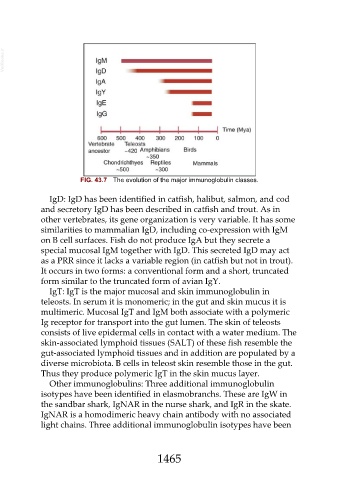Page 1465 - Veterinary Immunology, 10th Edition
P. 1465
VetBooks.ir
FIG. 43.7 The evolution of the major immunoglobulin classes.
IgD: IgD has been identified in catfish, halibut, salmon, and cod
and secretory IgD has been described in catfish and trout. As in
other vertebrates, its gene organization is very variable. It has some
similarities to mammalian IgD, including co-expression with IgM
on B cell surfaces. Fish do not produce IgA but they secrete a
special mucosal IgM together with IgD. This secreted IgD may act
as a PRR since it lacks a variable region (in catfish but not in trout).
It occurs in two forms: a conventional form and a short, truncated
form similar to the truncated form of avian IgY.
IgT: IgT is the major mucosal and skin immunoglobulin in
teleosts. In serum it is monomeric; in the gut and skin mucus it is
multimeric. Mucosal IgT and IgM both associate with a polymeric
Ig receptor for transport into the gut lumen. The skin of teleosts
consists of live epidermal cells in contact with a water medium. The
skin-associated lymphoid tissues (SALT) of these fish resemble the
gut-associated lymphoid tissues and in addition are populated by a
diverse microbiota. B cells in teleost skin resemble those in the gut.
Thus they produce polymeric IgT in the skin mucus layer.
Other immunoglobulins: Three additional immunoglobulin
isotypes have been identified in elasmobranchs. These are IgW in
the sandbar shark, IgNAR in the nurse shark, and IgR in the skate.
IgNAR is a homodimeric heavy chain antibody with no associated
light chains. Three additional immunoglobulin isotypes have been
1465

